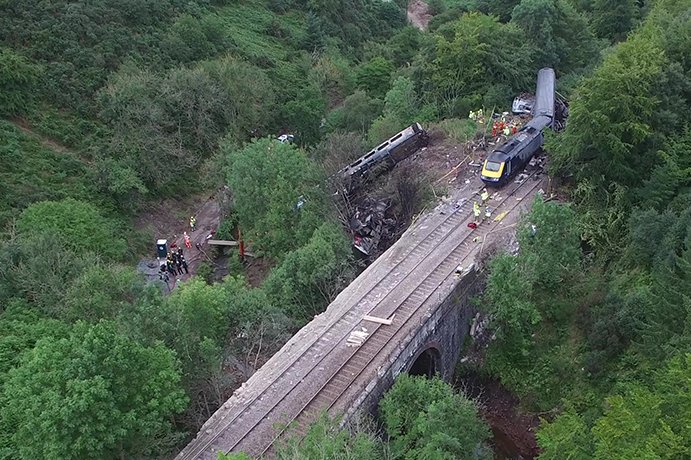Environment
Welcoming the European Year of Rail
After a challenging 2020, 2021 has been declared the European Year of Rail by the European Parliament and Council. Ilaria Grasso Macola finds out what the initiative is all about and what it means for the European railway sector.
E
ight months after the European Commission first proposed it, the European Parliament and Council reached a provisional agreement to declare 2021 the European Year of Rail on 12 November.
The year will feature a series of initiatives – such as dedicated events, exhibitions and campaigns – to promote rail as the most sustainable and innovative mode of transport, as well as support the delivery of the 2050 climate objectives highlighted in the European Green Deal.
“The European Year of Rail 2021 will put rail transport's many benefits in the spotlight, through dedicated events, exhibitions and promotional campaigns, reaching out to our citizens, in particular young people,” commented Commissioner for Transport Adina Vălean on the day. “I want to thank the European Parliament and the Council for their support for this initiative, which is part of our European Green Deal.”
The initiative was well received around the industry. “Declaring 2021 as European Year of Rail was a deliberate and most welcome decision to shine a light on rail’s important role in achieving EU Green Deal objectives,” said Community of European Railway and Infrastructure Companies (CER) executive director Libor Lochman.
“CER very much welcomes this decision paving the way for many engaging activities in 2021. We will certainly contribute [to] promoting rail to get more people and goods on tracks.”
Given its importance for the European railway sector, what is this initiative all about and what does it mean for European railways?

Aerial view of the derailment. Image: UK Government
How did the European Year of Rail come about?
Before the provisional agreement was reached by the parliament and council, the proposal for the European Year of Rail passed through all the stages of the European Union’s bureaucratic system.
The commission originally proposed it on 4 March, with Commissioner for Transport Adina Vălean saying: “There's no doubt that railway transport means huge benefits in most areas: sustainability, safety, even speed, once it's organised and engineered according to 21st-century principles.
“But there's also something more profound about railways: they connect the EU together not only in physical terms,” she added. “The European Year of Rail is not a random event. It comes at an appropriate time when the EU needs this kind of collective undertaking.”
Three and a half months later, on 24 June, the European Council’s Permanent Representative Committee agreed to negotiate a mandate on the proposal. The council also added a series of themes to the initiative, including the need for increased capacity of railway infrastructure, the role of railways in end-to-end mobility and passengers’ rights.
Rail will play a crucial role in helping the EU become climate neutral by 2050
“Environmentally-friendly and energy-efficient, rail will play a crucial role in helping the EU become climate neutral by 2050,” said the Croatian Minister for the Sea, Transport and Infrastructure Oleg Butković.
By mid-October, the European Year of Rail’s proposal was accepted by the European Parliament Committee on Transport and Tourism (TRAN), which applauded the initiative’s aim to boost railway’s attractiveness through targeted events.
“Rail, therefore, needs a further boost to become more attractive to passengers and businesses as a means of transport that meets both their daily and more long-distance mobility needs,” read the proposal. “By reaching out to citizens, beyond the railway sector, through dedicated events and communication campaigns, it will convince more people and businesses to make use of rail.”

A Google Earth image showing key locations to the crash. Image: UK Government
Reducing emissions across European railways
December 2019 saw the European Commission launch the European Green Deal, a set of policies to help Europe became the world’s first climate-neutral continent by 2050. As part of the deal, the transport sector – which accounts for a quarter of Europe’s greenhouse gases – has agreed to reduce its emissions by 90%.
To help the sector achieve its climate goals, the commission has been working on promoting rail’s role in the European mobility system of the future, focusing on railways’ environmental friendliness and energy efficiency.
Railways are widely seen as the most climate-friendly mode of transportation, continuously reducing their CO2 emissions since 1990. As reported by the European Commission, railways across the EU-28 produced 0.5% of emissions in 2017, compared to 72% produced by road transportation and 13.9% by aviation.
Initiatives such as the European Year of Rail are expected to help the EU achieve its climate goals, stepping up the pace of rail modernisation and customer engagement.
As part of the European Year of Rail, the European Council has tasked the commission to launch a feasibility study into the creation of a label to promote goods transported by rail. According to experts, the label will encourage businesses to switch to rail, furthering the commission’s plan to shift 75% of inland freight from road and aviation to rail and waterways by 2050.
The European Year of Rail will also help the industry regain attractiveness and passenger numbers after they plummeted because of the Covid-19 pandemic.
We want to stimulate meaningful discussions on how we can increase the number of passengers
According to a study published in May by German consultancy SCI Verkehr, as a result of Covid-19 travel restrictions, traffic demand dropped from 40% in Sweden to 90% in countries such as Italy and France, which were among the worst hit by Covid-19.
“With this agreement, we are paving the way for a successful European Year of Rail in 2021,” commented European Parliament Transport Committee Rapporteur Anna Deparnay-Grunenberg.
“Our ambition is to go beyond celebrating rail as an environmentally friendly mode of transport and an important cultural asset in Europe,” she added. “We also want to stimulate meaningful discussions on how we can increase the number of passengers and goods travelling by rail, in line with our climate ambitions.”
To increase the sector’s visibility, the European Commission chose 2021 as the Year of Rail because of its historical importance for the sector. In 2021, TGV will celebrate its 40th birthday, while will be the 20th anniversary of the first railway package and the 175th anniversary of the first railway link between Paris and Brussels.
2021 will also be the first year in which the Fourth Railway Package will be implemented throughout the continent.
The package – which was approved by the European Parliament in 2016 –created a single European railway area to make railways more competitive with other modes of transport. Measures in the Fourth Railway package include the Trans-European Transport (TEN-T) policy, which set out nine rail corridors across Europe.
Research, TEN-T and young talent
In addition to the European Green Deal, the European Year of Rail will help highlight a series of key initiatives, including Shift2Rail and the revision of the TEN-T regulation.
Officially named the Shift2Rail Joint Undertaking, Shift2Rail is a partnership between the public and private sector which aims to provide a platform to coordinate research activities and innovation in the rail sector.
Initially launched in 2014 under the funding research framework Horizon 2020, Shift2Rail focused on five innovation programmes, including building high-speed and high-capacity trains, sustainability and IT solutions.
In August 2020, the Commission invited private and public companies to form a European Partnership on Rail Research and Innovation, which is set to succeed the current Shift2Rail.
The European Year of Rail will also draw attention to the revision of the TEN-T regulation, set to take place in the second quarter of 2021. Initially started in July 2019, the revision process for TEN-T continued with a stakeholder consultation, which focused on several points, including the standards for the TEN-T infrastructure and digitalisation in the policy framework.
Hop On For Our Planet is a welcome initiative to attract skilled Europeans to the Rail Supply Industry
Experts also hope that the initiative will bring more young talent into rail. According to former European Economic and Social Committee member Alberto Mazzola, the European Year of Rail “should also be an opportunity to better communicate the attractiveness of a career in rail, especially to young Europeans, by supporting joint initiatives with social partners, universities, the academic community at large as well as European youth organisations."
One of those initiatives is Hop On For Our Planet, a campaign launched by the Association of European Rail Industry (UNIFE) to fast-track Europe’s green future through rail. The initiative is especially focused on recruiting from a younger pool talent that includes Gen-Z workers.
“Hop On For Our Planet is a welcome initiative to attract skilled Europeans to the Rail Supply Industry,” said TRAN member Dominique Riquet. “To remain world leaders in this field, we will need to show a new generation of innovators how they could have a role in Europe's twin transition".
“The campaign clearly demonstrates that rail is the way forward for sustainable transport infrastructure, innovative jobs and a lifetime of opportunity – especially amongst European Gen-Z who the survey revealed have much to learn about our industry,” added UNIFE chairman Henri Poupart-Lafarge.
Main image credit: Shutterstock | GarryKillian